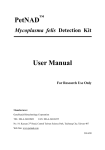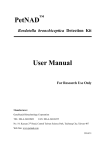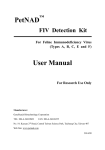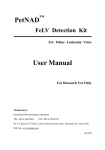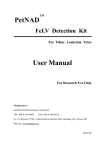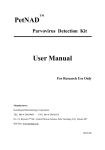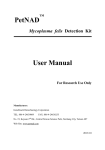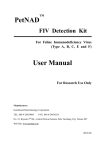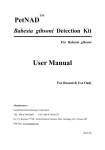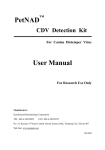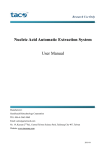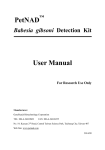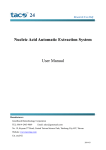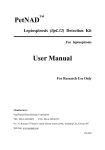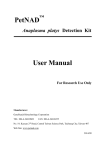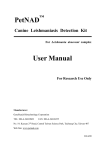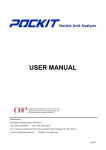Download User Manual (201409)
Transcript
™ PetNAD FCoV Detection Kit For Feline Coronavirus User Manual For Research Use Only Manufacturer: GeneReach Biotechnology Corporation TEL: 886-4-24639869 No. 19, Keyuan 2nd FAX: 886-4-24638255 Road, Central Taiwan Science Park, Taichung City, Taiwan 407 Web Site: www.petnad.com 2014/09 PetNAD™ FCoV Detection Kit Content INTENDED USE ................................................................................ 1 SCIENTIFIC MEANINGS ................................................................ 1 SUMMARY AND EXPLANATION................................................. 2 PRINCIPLES OF THE PROCEDURE ............................................ 3 PRODUCT DESCRIPTION.............................................................. 3 A. Materials Provided .................................................................................3 B. Materials and Equipments Required, but Not Provided .........................4 C. Storage and Stability ..............................................................................4 D. Sample Type...........................................................................................4 RECOMMENDED NUCLEIC ACID EXTRACTION METHODS .............................................................................................................. 5 PRECAUTIONS ................................................................................. 5 LIMITATIONS .................................................................................. 6 PROCEDURE ..................................................................................... 7 A. PetNAD™ FCoV Detection Kit Quick Guide .......................................7 B. Procedure ...............................................................................................8 DATA INTERPRETATION ........................................................... 10 i PetNAD™ FCoV Detection Kit ANALYTICAL SENSITIVITY ...................................................... 10 TROUBLESHOOTING ................................................................... 11 REFERENCE ................................................................................... 13 ii PetNAD™ FCoV Detection Kit INTENDED USE PetNAD™ FCoV Detection Kit is intended for in vitro detection of the Feline Coronavirus RNA based on insulated isothermal polymerase chain reaction (iiPCR) technology. This kit is designed specially to be used with an insulated isothermal (iiPCR)-compatible instrument, POCKIT™ Nucleic Acid Analyzer. The assay is intended for use by veterinarians or technicians with basic laboratory skills. This kit is intended for research use only. SCIENTIFIC MEANINGS Antibody induced by vaccine or obtained from maternal immunity could lead to false positive interpretation in antibody-based diagnostic procedures. Detecting pathogen’s nucleic acids, not antibody, PCRbased methods can avoid the false positive results described above. Furthermore, with higher analytical sensitivity, PCR can detect lower levels of viral signals than most if not all diagnostic methods. It can reduce the chance of false negative results at early infection stage and shorten the window period between time of infection and detection. 1 PetNAD™ FCoV Detection Kit SUMMARY AND EXPLANATION FCoV is an important feline pathogen world-wide. The enteric form of infection is limited to the gastrointestinal tract, leading to asymptomatic infections, mild enteritis, or fatal infectious peritonitis in cats (Pedersen et. al., 1981). FCoV, an enveloped positive-sense single-stranded RNA virus (Lai et. al., 2007), is highly contagious among cats by the fecaloral route. The virus is typically shed in feces by healthy recovered cats and can survive in the environment for up to 7 weeks (Hartmann, 2005). PCR is one of the most commonly accepted methods that provide high sensitivity and specificity for FCoV detection. However, conventional PCR assays could take three to four hours and require sophisticated thermocyclers and well-trained technicians to perform. GeneReach has developed PetNAD™ FCoV Detection Kit based on iiPCR technology, which significantly reduces reaction time and offers sensitivity and specificity comparable to those of conventional nested PCR (Tsai, 2012; Chang, 2012). Furthermore, this simple and easy assay is completed rapidly in a portable POCKIT™ Nucleic Acid Analyzer. 2 PetNAD™ FCoV Detection Kit PRINCIPLES OF THE PROCEDURE In iiPCR, hydrolysis probe-based chemistry is used to generate fluorescent signal during amplification of target RNA. The primers and probe target the M gene and do not cross-react with nucleic acid from host and other feline pathogens. PRODUCT DESCRIPTION A. Materials Provided (24 tests/kit) Component Premix Pack Premix Buffer Contents or Purpose P(+) Control FCoV Premix (lyophilized 24 bags (1 FCoV pellet) containing dNTPs, Premix vial and 1 primers, probe, and enzyme desiccating for amplification. agent/bag) Desiccating agent pack. Reaction buffer to re-dissolve B Amount 2 vials (1.3 ml/vial) the lyophilized pellet. Dried plasmid containing 1 vial FCoV partial sequence as positive control. P(+) Control Buffer Reaction buffer to re-dissolve 1 vial (110 μl/vial) P(+) Control. R-tube 1 bag (24 pieces/bag) 3 PetNAD™ FCoV Detection Kit Cap 1 bag (24 pieces/bag) User Manual 1 copy B. Materials and Equipment Required, but Not Provided 1) PetNAD™ Nucleic Acid Co-prep Kit or taco™ Automatic Nucleic Acid Extraction System. 2) POCKIT™ Nucleic Acid Analyzer (POCKIT™): PetNAD™compatible instrument. 3) cubee™ Mini-Centrifuge (cubee™). 4) Micropipette and filter tips. C. Storage and Stability 1) The kit should be stored at 4°C and is stable until the expiration date stated on the label. 2) Store Premix vials in sealed Premix Pack to avoid hydration of lyophilized components. 3) Reconstituted P(+) Control is stable for 6 months at 4°C. Aliquot reconstituted P(+) Control to avoid degradation of nucleic acid. D. Sample Type RNA extracted from whole blood, rectal swab, and pleural and abdominal effusion. 4 PetNAD™ FCoV Detection Kit RECOMMENDED NUCLEIC ACID EXTRACTION METHODS A. PetNAD™ Nucleic Acid Co-prep Kit. B. taco™ DNA/RNA Extraction Kit, compatible instrument— taco™ Automatic Nucleic Acid Extraction System. Note: Please follow the instruction manual of above extraction methods to obtain optimal results. It is the user’s responsibility to validate the combination of this reagent set with nucleic acids extracted by other methods for any particular application. PRECAUTIONS A. Do not open R-tube(s) after reaction to prevent any carryover contamination. B. Perform extraction and amplification in two independent spaces to minimize contamination. C. Do not reuse R-tube and Premix. D. Include the P(+) Control to: 1) Ensure POCKIT™ is working normally. 2) Ensure detection kit performance after storage. 5 PetNAD™ FCoV Detection Kit E. To get optimal fluorescence detection. 1) Wear powder-free gloves to Labeling area handle R-tubes. 2) Do not label in the detection area Detection area of R-tube. LIMITATIONS A. The test should be used only for testing nucleic acid extracted from animal specimens. Do not add specimens (e.g. whole blood) directly into Premix. B. PetNAD™ Nucleic Acid Co-prep Kit and taco™ mini Automatic Nucleic Acid Extraction System are recommended for nucleic acid extraction. C. Any deviations from the recommended procedure may lead to suboptimal results. Quality of the extracts should be validated by the users. D. For PetNAD™ FCoV Detection Kit, it is strongly recommended to use freshly prepared nucleic acid (within 1 hour after extraction) to achieve optimal results. 6 PetNAD™ FCoV Detection Kit PROCEDURE A. PetNAD™ FCoV Detection Kit Quick Guide 7 PetNAD™ FCoV Detection Kit B. Procedure Note: Before preparing the reactions for iiPCR testing, turn on POCKIT™ to initiate the calibration for the instrument. The device will complete self-test within 5 minutes. Please refer to the user manual of POCKIT™ for further details. Note: Before using for the first time, add 100 μl P(+) Control Buffer to P(+) Control. Store reconstituted P(+) Control at 4°C. 1) Label R-tube(s) in the label area. 2) Prepare one Premix for each sample. (Premix tube is in Premix Pack. Each Premix Pack contains one Premix tube.) Note: When the pellet is not found at the bottom of the tube, spin tube briefly to bring it down. 3) Add 50 μl Premix Buffer B to each Premix tube. 4) Add 5 μl nucleic acid extract or P(+) Control to each Premix tube. Spin Premix tube for 10 seconds in a mini centrifuge (such as cubee™). 5) Transfer 50 μl Premix/sample mixture into R-tube. 6) Seal top of each R-tube with a cap. Make sure R-tube is capped tightly. 7) Place R-tube into the holder of POCKIT™. 8) Spin tube briefly in cubee™ to make sure all solution is 8 PetNAD™ FCoV Detection Kit collected at the bottom of R-tube. Note: Make sure there are no bubbles in the solution. Note: Start reaction within 1 hour (to prevent nucleic acid degradation and non-specific reaction). 9) POCKIT™ reaction: a) Select ″520 nm″. b) When ″System READY″ is displayed, place the holder with R-tube(s) into the reaction chamber. c) Tap cap of each R-tube to make sure the tube is positioned properly. 10) Close lid and press ″Run″ to start reaction program. 11) Test results are shown on the monitor after reaction is completed. 9 PetNAD™ FCoV Detection Kit DATA INTERPRETATION * One example of results shown on the monitor. 520 nm Interpretation FCoV Positive. FCoV Negative. Repeat reaction with freshly prepared nucleic acid. ANYLYTICAL SENSITIVITY The detection limit of PetNAD™ FCoV Detection Kit is about 10 copies/reaction. 10 PetNAD™ FCoV Detection Kit TROUBLESHOOTING Problems Possible causes Solutions False Positive 1) Reuse of micro- Micro-centrifuge tubes, tips, R- centrifuge tubes, tubes and Premix are for single-use tips, R-tubes and only. Reusing these accessories Premix. would cause cross-contamination, and therefore false positive results. Used micro-centrifuge tubes, tips, R-tubes and Premix should be collected and discarded according to local regulation. Do not place the waste close to the working area to prevent cross-contamination. Use aerosol-free tips. 2) Contaminated micropipette Consult with a GeneReach 3) Contaminated reagent technical support representative or local distributor. Consult with a GeneReach 4) Contaminated working area technical support representative on how to clean up working area. 11 PetNAD™ FCoV Detection Kit Problems Possible causes Solutions False 1) Nucleic acid Consult manual of nucleic acid Negative extraction failed. extraction kit. Do not overload PCR with too 2) PCR inhibition much nucleic acid. Spike nucleic acid sample (5 μl) into a P(+) Control reaction for a parallel PCR reaction. Negative results indicate the presence of inhibitors in the nucleic acid. In that case, prepare another nucleic acid extract. Heavy Consult with a GeneReach 1) Leakage or spill of contamination reaction from R- technical support representative or of amplicons tube into reaction local distributor. in reaction chamber of chamber of POCKIT™. POCKIT™. 12 PetNAD™ FCoV Detection Kit REFERENCE 1. 2. 3. 4. 5. Chang, H.F. G., Tsai, Y.L., Tsai, C.F., Lin, C.K., Lee, P.Y., Teng, P.-H., Su, C. and Jeng, C.C., (2012) A thermally baffled device for highly stabilized convective PCR. Biotechnology Journal 7(5): 662-666, doi: 10.1002/ biot.201100453 Hartmann, K. (2005). Feline infectious peritonitis. Vet Clin North Am Small Anim Pract. 2005 Jan;35(1):39-79 Lai MMC., Perlman S., Anderson L.J., (2007). Coronaviridae. In: Knipe DM, Howley PM, Griffin DE, Lamb RA, Martin MA, Roizman B, Straus SE, eds. Fields virology. Lippincott Williams & Wilkins, Philadelphia, PA, 1305-1335. Pedersen, N.C., Boyle, J.F., Floyd, K., Fudge, A. and Barker, J., (1981). An enteric coronavirus infection of cats and its relationship to feline infectious peritonitis. Am J Vet Res 42: 368-377. Tsai Y.L., Wang H.T. T., Chang H.F. G., Tsai C.F., Lin C.K., Teng P.H., Su C. and Jeng C.C., (2012). Development of TaqMan probe-based insulated isothermal PCR (iiPCR) for sensitive and specific on-site pathogen detection. PLoS ONE 7(9): e45278. doi: 10.1371/ journal. pone. 0045278 13

















